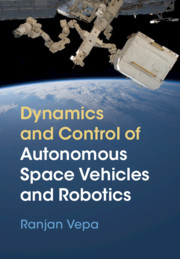Refine search
Actions for selected content:
2002 results in Engineering design, kinematics, and robotics
5 - Research and Development Projects for AAL Systems
-
- Book:
- Ambient Integrated Robotics
- Published online:
- 09 July 2019
- Print publication:
- 27 June 2019, pp 104-139
-
- Chapter
- Export citation
References
-
- Book:
- Ambient Integrated Robotics
- Published online:
- 09 July 2019
- Print publication:
- 27 June 2019, pp 148-158
-
- Chapter
- Export citation
Copyright page
-
- Book:
- Ambient Integrated Robotics
- Published online:
- 09 July 2019
- Print publication:
- 27 June 2019, pp iv-iv
-
- Chapter
- Export citation
Index
-
- Book:
- Ambient Integrated Robotics
- Published online:
- 09 July 2019
- Print publication:
- 27 June 2019, pp 159-164
-
- Chapter
- Export citation
3 - Built Environment Upgrading for AAL (BeuAAL)
-
- Book:
- Ambient Integrated Robotics
- Published online:
- 09 July 2019
- Print publication:
- 27 June 2019, pp 37-73
-
- Chapter
- Export citation
Index
-
- Book:
- Dynamics and Control of Autonomous Space Vehicles and Robotics
- Published online:
- 29 April 2019
- Print publication:
- 02 May 2019, pp 349-352
-
- Chapter
- Export citation
1 - Introduction to Autonomous Space Vehicles and Robotics
-
- Book:
- Dynamics and Control of Autonomous Space Vehicles and Robotics
- Published online:
- 29 April 2019
- Print publication:
- 02 May 2019, pp 1-27
-
- Chapter
- Export citation
8 - Sensing and Estimation of Spacecraft Dynamics
-
- Book:
- Dynamics and Control of Autonomous Space Vehicles and Robotics
- Published online:
- 29 April 2019
- Print publication:
- 02 May 2019, pp 308-348
-
- Chapter
- Export citation
Copyright page
-
- Book:
- Dynamics and Control of Autonomous Space Vehicles and Robotics
- Published online:
- 29 April 2019
- Print publication:
- 02 May 2019, pp iv-iv
-
- Chapter
- Export citation
7 - Navigation and Localization
-
- Book:
- Dynamics and Control of Autonomous Space Vehicles and Robotics
- Published online:
- 29 April 2019
- Print publication:
- 02 May 2019, pp 257-307
-
- Chapter
- Export citation
Dedication
-
- Book:
- Dynamics and Control of Autonomous Space Vehicles and Robotics
- Published online:
- 29 April 2019
- Print publication:
- 02 May 2019, pp v-vi
-
- Chapter
- Export citation
Acronyms
-
- Book:
- Dynamics and Control of Autonomous Space Vehicles and Robotics
- Published online:
- 29 April 2019
- Print publication:
- 02 May 2019, pp xvii-xviii
-
- Chapter
- Export citation
Contents
-
- Book:
- Dynamics and Control of Autonomous Space Vehicles and Robotics
- Published online:
- 29 April 2019
- Print publication:
- 02 May 2019, pp vii-xiv
-
- Chapter
- Export citation
2 - Space Vehicle Orbit Dynamics
-
- Book:
- Dynamics and Control of Autonomous Space Vehicles and Robotics
- Published online:
- 29 April 2019
- Print publication:
- 02 May 2019, pp 28-117
-
- Chapter
- Export citation
5 - Kinematics, Dynamics, and Control of Mobile Robot Manipulators
-
- Book:
- Dynamics and Control of Autonomous Space Vehicles and Robotics
- Published online:
- 29 April 2019
- Print publication:
- 02 May 2019, pp 206-228
-
- Chapter
- Export citation
6 - Planetary Rovers and Mobile Robotics
-
- Book:
- Dynamics and Control of Autonomous Space Vehicles and Robotics
- Published online:
- 29 April 2019
- Print publication:
- 02 May 2019, pp 229-256
-
- Chapter
- Export citation
Preface
-
- Book:
- Dynamics and Control of Autonomous Space Vehicles and Robotics
- Published online:
- 29 April 2019
- Print publication:
- 02 May 2019, pp xv-xvi
-
- Chapter
- Export citation
3 - Space Vehicle Attitude Dynamics and Control
-
- Book:
- Dynamics and Control of Autonomous Space Vehicles and Robotics
- Published online:
- 29 April 2019
- Print publication:
- 02 May 2019, pp 118-166
-
- Chapter
- Export citation
4 - Manipulators on Space Platforms
-
- Book:
- Dynamics and Control of Autonomous Space Vehicles and Robotics
- Published online:
- 29 April 2019
- Print publication:
- 02 May 2019, pp 167-205
-
- Chapter
- Export citation

Dynamics and Control of Autonomous Space Vehicles and Robotics
-
- Published online:
- 29 April 2019
- Print publication:
- 02 May 2019
